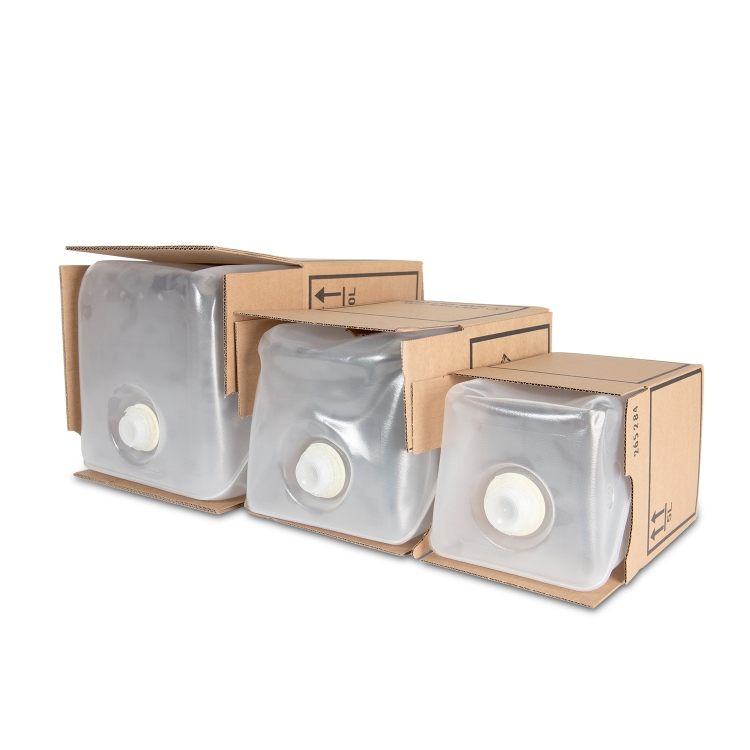Bag‑In‑Box (often abbreviated as BIB) is a packaging solution that combines a flexible plastic bladder with a rigid cardboard outer shell. Since its commercial debut in the 1960s, the bag‑in‑box format has gained favor across food, beverage, chemical and pharmaceutical sectors for its ability to preserve product quality, reduce shipping costs and simplify handling.
In this article, we’ll explore exactly what a bag‑in‑box is, survey the main variants on the market, examine which industries depend on BIB systems most heavily, and finally, show how bag‑in‑box making machines bring these clever packages to life.

A bag‑in‑box consists of 2 components: an inner bag made from multiple layers of plastic film and an outer carton made from corrugated or solid‑board paper. The inner bag can collapse as its contents are dispensed, preventing air from entering and prolonging shelf life. The outer carton provides structural support, making the package easy to stack, transport and display. Most BIB designs also include a spout or tap that clips into the bag’s outlet, ensuring precise, drip‑free pouring.
Because the inner bag conforms to the shape of its contents, bag‑in‑box packaging uses space more efficiently than rigid containers, cutting down on wasted void filler when pallets are loaded for shipping. The lightweight nature of the plastic film also trims transport weight and carbon emissions compared with glass bottles or metal drums.

BIB packages vary in materials, capacity and dispensing mechanism. In food and beverage applications, inner bags often feature an oxygen‑barrier layer—such as EVOH (ethylene vinyl alcohol)—to protect sensitive liquids like wine and fruit juice. Simpler BIBs may use plain polyethylene for products where barrier properties are less critical, such as bulk cooking oil or dairy.
Dispensing fittings range from snap‑on plastic taps, which are cost‑effective for single‑serve juice pouches, to threaded screw valves that deliver airtight seals for premium wines and chemical reagents. Some high‑volume industrial BIBs are fitted with sanitary stainless‑steel couplings for automated filling and emptying in food‑processing or pharmaceutical pipelines. Capacities span from one‑ to five‑liter consumer packs all the way up to 20‑ to 25‑liter commercial sizes, and even 200‑liter inner bags that sit inside steel or plastic drums.
The versatility of bag‑in‑box means it shows up in a surprising range of settings. In the food and beverage world, BIBs hold everything from boxed wine and cold‑brew coffee to cooking oils, ketchup and salad dressings. Restaurateurs and caterers value BIBs for saving space in the kitchen and speeding up service, while wineries appreciate their low‑oxygen draw‑down for preserving wine freshness over weeks once opened.
In chemical and pharmaceutical industries, bag‑in‑box is prized for transporting solvents, reagents and liquid intermediates under airtight conditions. The collapse‑to‑empty characteristic reduces product loss and eases residue recovery when batches are processed in mixing tanks.
Meanwhile, personal‑care companies use BIBs as economical refill packs for shampoo, lotion and hand soap, cutting plastic waste by allowing customers to reuse a pump dispenser.
So, to produce such BIB bags for food, chemical or health care, you need a BIB bag making machine.
Having looked at what bag‑in‑box packaging is and where it’s used, it’s time to turn to the machines that actually make these packages. To produce a BIB you need a coordinated production line capable of cutting film to size, forming and sealing the inner bag, mounting the tap fitting, filling the bag with liquid and finally erecting and packing the carton around it.
A typical bag‑in‑box bag making machine starts by unwinding rolls of laminated film and feeding them through a heat‑sealing station, where the inner pouch is formed and cut to the desired dimension. Next, an automated valve insertion unit aligns and welds the dispensing spout onto the bag. Once the tap is secured, the pouch moves to a precision filling station, often equipped with flow meters or load cells to ensure each bag holds the exact volume. After filling, a final sealing step locks in the liquid and the finished bag advances to an in‑line leak detection module.
At the end of the line, a carton erecting and loading machine sets up the corrugated box, inserts the filled bag, closes the flaps and applies case sealing tape. Modern BIB production lines can run at speeds exceeding 400 bags per hour, and many are designed with quick‑change tooling so manufacturers can switch between sizes or valve types in minutes rather than hours.
We have 2 kinds of machines to manufacture BIB bags, click the picture to know the details:
Feel free to contact us! Feel free to contact us! Feel free to contact us!